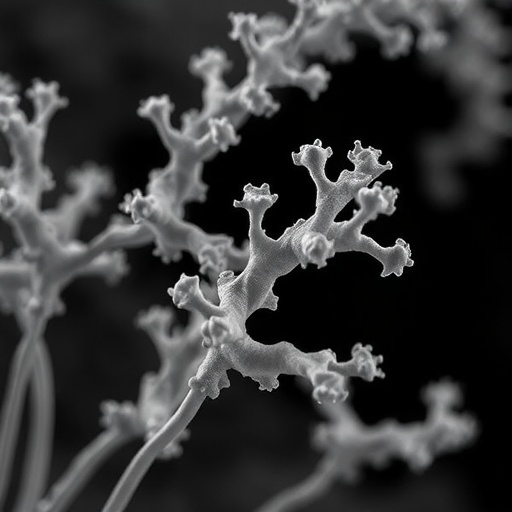In a groundbreaking study published in the journal Molecular Diversity, researchers have made significant strides in understanding the molecular dynamics of pathogenic bacteria, particularly focusing on Nocardia farcinica, a microbial strain notorious for its virulence and propensity for antibiotic resistance. Through advanced computational methods, the team embarked on an exploration into a novel protein characterized by its alpha/beta hydrolase fold domain. This protein’s unique structure and functional capabilities suggest a pivotal role in the survival and pathogenicity of N. farcinica, offering valuable insights that could inform future therapeutic strategies.
Copious quantities of information about Nocardia farcinica have revealed its alarming resilience against conventional antibiotic treatments. This bacterium is often implicated in severe infections, particularly in immunocompromised patients. The recent investigation by Nathar et al. (2025) aimed to elucidate the specific molecular mechanisms that underlie its virulence and resistance. The deployment of in silico techniques was a key aspect of their research, allowing for extensive data analysis and protein modeling without the immediate necessity of laboratory-based experiments.
In silico identification of novel protein structures has become a game-changer in the field of microbiology. The robustness of these methods enabled the research team to detect and characterize the alpha/beta hydrolase fold domain-containing protein. This particular domain is well known for its involvement in various biochemical processes, including hydrolysis reactions, which are critical for bacterial life. The identification of such a domain in N. farcinica may correlate directly to the bacterial strain’s ability to degrade host tissue or evade the immune response, thereby exacerbating infections.
Molecular modeling techniques, particularly homology modeling and molecular dynamics simulations, were employed to predict the structure and behavior of the identified protein under physiological conditions. These simulations provide insights that are often difficult to achieve through experimental methods alone, especially for proteins that are challenging to crystallize. The researchers were able to visualize how the protein folds and interacts with ligands, which is essential for assessing its functional roles in the context of virulence and resistance.
One of the most compelling findings of the study was the implication that this newly identified protein could serve as a potential target for drug development. By understanding the structural nuances and mechanistic functions of this hydrolase, scientists could design inhibitors that specifically target the protein’s active site. These inhibitors could potentially disrupt the bacterial pathways that lead to virulence and resistances, thus presenting a novel approach to tackling Nocardia farcinica infections.
Moreover, the study highlighted the importance of interdisciplinary collaboration. By merging principles of bioinformatics, structural biology, and microbiology, the research transcended traditional disciplinary boundaries, paving the way for innovative approaches in infectious disease management. The exploration of protein functionality through computational methods not only enhances our understanding of bacterial pathophysiology but also inspires a new paradigm in how researchers address the escalating issue of antimicrobial resistance.
The findings from Nathar et al. also align with a broader trend in the scientific community: the urgent need to combat antimicrobial resistance through novel strategies. As resistance rates in pathogenic bacteria continue to rise, there is an increasing urgency to identify and validate new drug targets. The alpha/beta hydrolase fold domain presents an enticing opportunity for drug developers to exploit bacterial vulnerabilities that have yet to be fully harnessed.
In conclusion, the in silico identification of new protein domains in Nocardia farcinica not only reveals crucial insights into the virulence mechanisms of this opportunistic pathogen but also sets the stage for the development of innovative therapeutic strategies. The research team’s work emphasizes the power of computational biology in posing solutions to one of the most pressing issues in public health today: the fight against antibiotic-resistant infections. As scientists continue to delve into the molecular intricacies of such pathogens, it is hoped that future discoveries will lead to effective treatments that can save countless lives.
The implications of these findings extend beyond merely adding to a repository of scientific knowledge. They also underscore the urgent need for ongoing research aimed at elucidating the complexities of bacterial resistance mechanisms. As the scientific community mobilizes to understand and combat rising threats like Nocardia farcinica, the contributions of studies like these become invaluable. The potential for translating insights from the molecular level into tangible clinical innovations represents a beacon of hope in the battle against infectious diseases.
In summary, this landmark study serves as a critical reminder of the power of in silico research and the importance of interdisciplinary approaches in modern science. As the capabilities of computational tools continue to evolve, the horizon for discovering new therapeutic targets will undoubtedly expand, empowering researchers to meet the challenges posed by antibiotic resistance head-on.
Subject of Research: In silico identification of novel alpha/beta hydrolase fold domain-containing protein associated with virulence and antibiotic resistance in Nocardia farcinica.
Article Title: In silico identification of novel alpha/beta hydrolase fold domain-containing protein associated with virulence and antibiotic resistance in Nocardia farcinica (Strain: JJSBBCNF_01).
Article References:
Nathar, S., Nagarajan, H., Narthanareeswaran, B. et al. In silico identification of novel alpha/beta hydrolase fold domain-containing protein associated with virulence and antibiotic resistance in Nocardia farcinica (Strain: JJSBBCNF_01).
Mol Divers (2025). https://doi.org/10.1007/s11030-025-11415-z
Image Credits: AI Generated
DOI: https://doi.org/10.1007/s11030-025-11415-z
Keywords: Nocardia farcinica, antibiotic resistance, virulence, alpha/beta hydrolase fold, in silico identification, protein modeling, molecular dynamics simulations.
Tags: alpha/beta hydrolase fold proteinantibiotic resistance mechanismscomputational methods in microbiologyin silico protein modeling techniquesmicrobiology advancements 2025molecular dynamics of NocardiaNocardia farcinica research findingsNocardia farcinica virulence factorsnovel protein structure identificationpathogenic bacteria researchsevere infections in immunocompromised patientstherapeutic strategies for bacterial infections





